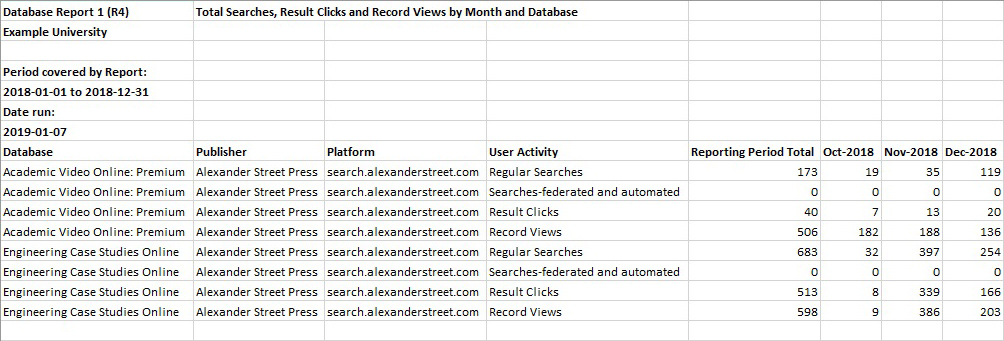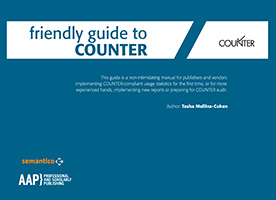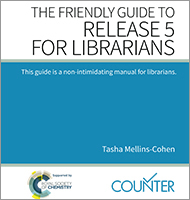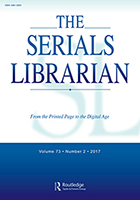| COUNTER (Counting Online Usage of NeTworked Electronic Resources) is an organization and a set of standards to report usage of library electronic resources by vendors and publishers. |
Why understand COUNTER reports?
When database vendors and publishers use different methods of counting and reporting usage of their platforms and items, it is difficult for librarians to determine accurate use counts (and rejections). Thus, it is hard to calculate the cost-per-use. Different figures often make database comparison difficult when deciding between the value of two similar products.
COUNTER provides a way to standardize and compare database usage statistics across vendors and time.
COUNTER reports can also show demand for titles not owned by reporting access denied to books (BR3) and journals (JR2). These reports can be helpful for library resource acquisition decisions.
The Basics
 There are four types of item-type usage reports each with their unique statistics:
There are four types of item-type usage reports each with their unique statistics:
- Books – Electronic or print monographs, including reference works.
- Journals – Serials including conference proceedings and newspapers.
- Media – Non-text items such as images and video.
- Databases – Collections of online data.
The Title report is a combination of book and journal counts.
The Consortium report counts all usage across a group of institutions.

COUNTER statistics are reported on a monthly basis and reports can typically cover any custom time period in addition to calendar year.
Reports are distributed electronically. Sometimes they are available from vendors as immediate downloads, but other times they must be requested and emailed. “COUNTER reports are available in two formats: delimited files, which are readable using Excel and similar spreadsheet tools, and XML, which is delivered using SUSHI.” The two types of delimited files are comma-separated value (CSV) and tab-separated value (TSV) files.

Download an example COUNTER report.
If the vendor allows, you can avoid the manual running and downloading of COUNTER reports. COUNTER offers an automated way to accomplish this using the SUSHI protocol. “The Standardized Usage Statistics Harvesting Initiative (SUSHI) protocol is designed to simplify the gathering of usage statistics by librarians, and it uses a series of XML schemas to do this.”
The current version in widespread use is COUNTER 4, however some vendors still offer archived usage statistics using version 3. COUNTER 5 is available and we will see vendors moving to it gradually. EBSCO just announced that it is making its usage reports available in COUNTER 5 format.
While version 5 is the future, COUNTER 4 is still by far the most common version offered by vendors today. Below is a list of all COUNTER 4 reports with a brief description of each. Vendors, depending on their size and content, usually offer a subset of these reports.
Book Reports
Version 4 has six reports on book (ebook) usage at both the book and chapter (or section) levels.
BR1 – Counts whole book access only
BR2 – Counts book content accessed in sections
BR3 – Counts access denied book sections
BR4 – Counts access denials at the service (collection) level
BR5 – Counts regular and federated searches of single books
BR6 – [Not used]
BR7 – Counts whole book and section access (BR1+BR2)
Consortium Reports
Consortium reports do not count specific resource types. They provide a wide, multiple-institutional usage view. “Consortium reports were designed to allow consortia to see usage information from all member institutions in a single report.”
CR1 – Counts book chapter or journal article access (BR7+JR1)
CR2 – Counts searches of databases
CR3 – Counts multimedia access
Database Reports
Database reports provide figures at the database or platform level. A platform might contain multiple databases. A database might contain a mix of books, journals, and media.
DB1 – Counts database searches, result clicks, and record views
DB2 – Counts database access denied to content
PR1 – Counts platform searches, result clicks, and record views
Journal Reports
Journal reports are possibly the heart of COUNTER. Thus, there are more and varied reports for journal- and article-level usage.
JR1 – Counts full-text article access (views and downloads) by journal
JR1-GOA – Counts Gold Open Access (GOA) articles (similar to JR1)
JR1a – Counts article access (like JR1) from archives [optional report]
JR1b – Counts article access (like JR1) by platform [optional report]
JR2 – Counts access denied to full-text journal articles
JR3 – Counts journal article full-text, sections, and files [optional report]
JR3 Mobile – Similar to JR3 but from mobile devices [optional report]
JR4– Counts journal searches by collection [optional report]
JR5 – Counts full-text article access by year of publication
Multimedia Reports
Less common are multimedia reports. “Multimedia means items of non-textual media content such as images, maps, streaming or downloadable audio or video files.”
MR1 – Counts full, standalone multimedia content access by collection
MR2 – Counts multimedia by collection and item type [optional report]
Title Reports
Title reports allow for simultaneous reporting of book and journal content and are provided in XML format only due to size. All title reports are optional.
TR1 – Counts full-text book section or journal article access by title
TR1m – Same as TR1 but formatted for display on mobile devices
TR2 – Counts access denied full-text items by title and category
TR3 – Counts book and journal items by title and page type
TR3m – Same as TR3 but formatted for display on mobile devices
Resources
Here are some great online resources to learn about COUNTER:
- Project COUNTER – The main site for the COUNTER organization.
- SUSHI – A NISO standard for automatic COUNTER report harvesting.
- SUSHI for Librarians – Getting Started guide and FAQ.
- Usus – A community of users of COUNTER and SUSHI with tips.
- EBSCO – COUNTER reports FAQ.
- Ex Libris – Using COUNTER with Alma.
- Gale – Information on usage reports offered including COUNTER.
- OCLC – Information on provided COUNTER reports and SUSHI.
- ProQuest – COUNTER Reports information and what is provided.
Articles and books about COUNTER:
Friendly Guide to Counter by Tasha Mellins-Cohen

This short manual is written for publishers and database vendors but gives helpful basic information about COUNTER reports. Published in 2016.
Access the full-text guide (PDF).
The Friendly Guide to Release 5 for Librarians by Tasha Mellins-Cohen

This new manual gives an introduction to COUNTER and basic information about COUNTER 5 reports and how they differ from COUNTER 4 versions. Published in 2018.
Access the full-text guide (PDF).
Getting Started with COUNTER Statistics by Jennifer J. Leffler

Article from The Serials Librarian. Although the article is a summary of a conference workshop, it provides some helpful information with basic COUNTER use. Published in 2016.
